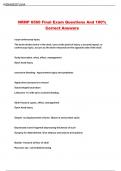AGRADESTUVIA
NRNP 6560 Final Exam Questions And 100%
Correct Answers
coup-contrecoup injury
The brain strikes twice in the skull, once at the point of injury; a second impact, or
contrecoup injury, occurs as the brain rebounds on the opposite side of the skull.
Scalp laceration: what, effect, management
Open head injury
excessive bleeding - hypovolemia signs and symptoms
Apply direct pressure to wound
Suture/staple laceration
Lidocaine 1% with epi to control bleeding
Skull fracture: types, effect, management
Open head injury
Simple: no displacement of bone. Observe and protect spine
Depressed: bone fragment depressing thickness of scull
Surgery for debridement. Give tetanus and seizure precautions
Basilar: fracture at floor of skull
Raccoon eye - periorbital bruising
,AGRADESTUVIA
battle's sign: mastoid bruising
otorrhea/ rhinorrhea - halo sign: do not obstruct flow
Give Ab's
Oral intubation and oral gastric instead of nasal
Brain injury: types, effect, management
Primary head injury
Concussion: reversible change in brain functioning
loss of consciousness, amnesia
Do not give opioids, admit for unconsciousness > 2min
Contusion: bruising to surface of brain w/ edema
Frontal and temporal region
Brainstem contusion: posturing, variable temp, variable vital signs
N/V, dizzy, visual changes
seizure precautions
Hematoma - neuro: types, effect, management
Epidural hematoma: most commonly temporal/ parietal region w/ skull fracture, bleeding
into epidural space
Loss of consciousness
Rapid deterioration: obtunded, contralateral hemiparesis, ipsilateral pupil dilation
,AGRADESTUVIA
CT scan (non contrast)
Treatment based on Brain trauma foundation. Surgical if greater than 30cm
Subdural hematoma
most common type of intracranial bleed
Acute (hours): drowsy, agitated, confused, headache, pupil dilation,
CT scan (noncontrast)
surgery for 10mm thickness or 5mm midline shift or for worsening GCS
Chronic (days): headache, memory loss, incontinence
CT scan (noncontrast)
Surgery: burr holes/ crani
Cerebral edema/ ICP elevated/ herniation: symptoms, management
decreased level of consciousness
Blown pupil
Cushing triad: HTN (widening pulse pressure), decreased resp rate, bradycardia
(means increased intracranial pressure)
Neuro exam components
AVPU: awake, response to verbal stimuli, painful stimuli, unresponsive
GCS: 8 or below is comatose
Posturing:
decorticate = arms, legs in
, AGRADESTUVIA
decerebrate = arms, legs out
Electrolyte imbalances in brain injury
Hyponatremia: SIADH and cerebral salt wasting
Hypernatremia: DI (give mannitol)
Management of traumatic brain injury
- Consult neurosurgery
- Limit secondary injury
- Avoid hypotension (syst 90) and hypoxemia (PaO2 60). Consider blood administration
to maintain tissue perfusion.
- Cerebral oedema: elevation of the bed, sedation, paralysis, mannitol, hyperventilation
(PaCO2 25-30), first 24 hrs
- Sedation and Analgesia: Opioids to prevent increase in ICP-Fentanyl, may be given
with Propofol. May give Nimbex or Vec. to aid oxygenation/ventilation
- Steroids: Avoid
- Mannitol or hypertonic saline for herniation: bolus then gtt. Monitor serum osmolality,
sodium and BP.
-Seizure precautions- give phenytoin or keppra
-DVT prophylaxis- stockings, LMWH
-head injury means spine injury until proven otherwise
-hypothermia: can control ICP (89 - 91F)
-decompressive crani: ICP refractory to tx
-brain O2 monitoring (jugular vein O2 sats)
ICP monitoring
Indications: GCS 3-8 with abnormal CT and comatose pt's with normal CT and older than
40, posturing, hypotension.
Normal value: 5-10 mmHg
Recommend starting treatment if ICP > 20 mmHG.




